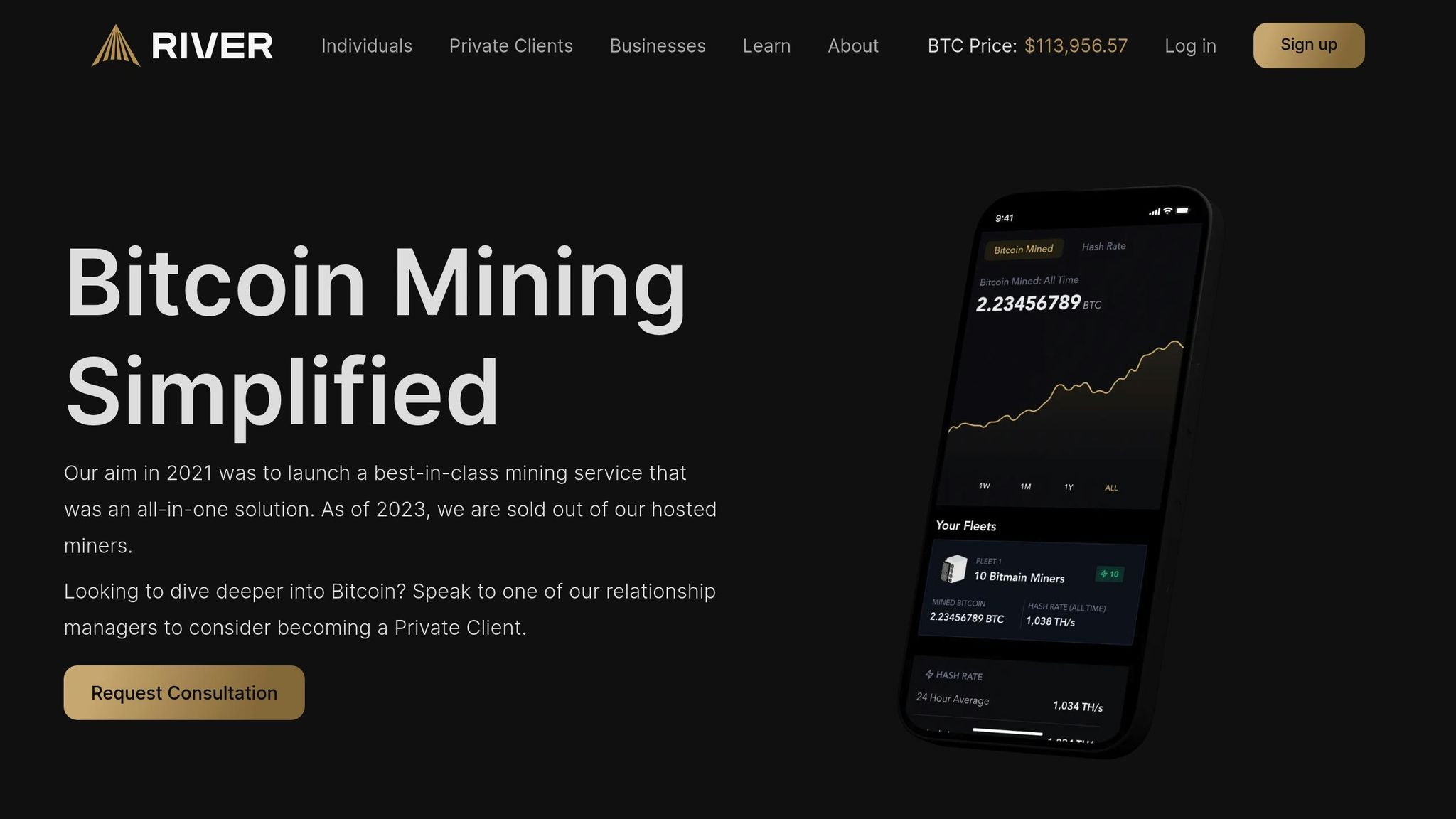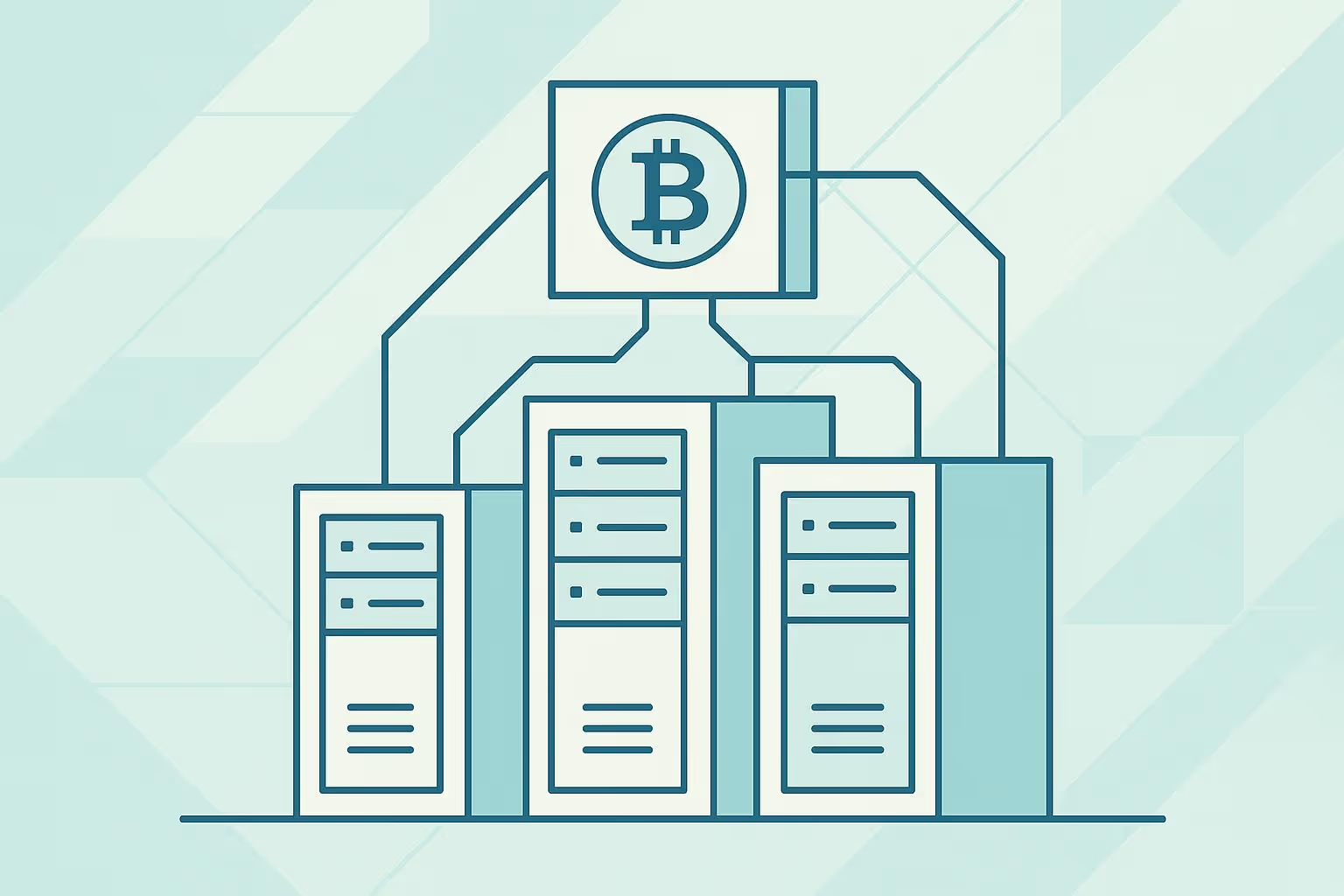Mining-as-a-Service (MaaS) simplifies Bitcoin mining by managing the technical and logistical challenges for you. Instead of setting up and maintaining mining rigs yourself, MaaS providers handle everything - from hosting and maintenance to payouts. Here’s a quick breakdown of why this model appeals to miners:
- Lower upfront costs: MaaS setups range from $3,847 to $12,937, compared to $2,630–$23,850 for home mining.
- Predictable monthly expenses: MaaS costs $230–$250/month, while home setups can exceed $300/month.
- No technical expertise required: Providers manage hardware, cooling, and troubleshooting.
- Energy savings: Many providers use renewable energy, offering rates as low as $0.067/kWh, far below the U.S. average of $0.13/kWh.
- Direct Bitcoin payouts: Earnings go straight to your wallet, with performance tracking tools included.
MaaS simplifies scaling, offers transparent pricing, and reduces risks associated with self-managed mining. If you’re looking for a hands-off, cost-effective way to mine Bitcoin, MaaS could be the right choice.
Custodial Bitcoin Mining w/ Compass Mining or River?

Main Cost Components of Mining-as-a-Service
Every cost factor - whether it's the upfront hardware investment or the ongoing operational expenses - plays a critical role in determining the profitability of Mining-as-a-Service (MaaS). Having a clear understanding of these costs is essential for assessing potential returns and making smart investment choices. The overall expenses can be grouped into three main categories, each with a distinct impact on your financial outcomes.
Mining Rig Purchase Costs
The biggest initial expense is the cost of the mining hardware itself. Prices for mining rigs can vary widely depending on their performance, energy efficiency, and market demand.
Take Bitmain's S19 XP Hydro models as an example: the 246 TH/s version is priced at $3,847, while the 257 TH/s model costs $3,997. Both operate at an energy efficiency of 20.8 J/TH. While more efficient rigs come with a higher upfront cost, they can lead to greater profitability over time. However, the hardware cost is just the beginning - ongoing expenses like hosting and electricity fees also play a major part in shaping overall profitability.
Hosting and Electricity Fees
Electricity is one of the most significant ongoing expenses in Bitcoin mining. For context, the average electricity price in the U.S. is around $0.17 per kWh, which is generally too high to support profitable mining operations. This is where MaaS providers step in, offering access to low-cost energy, often sourced from renewable power.
Hosting fees typically include a fixed monthly service charge - $239 for a 246 TH/s model and $250 for a 257 TH/s model - along with a revenue-sharing arrangement that ranges from 15% to 20%. The revenue share varies by location, reflecting differences in local energy costs and operational challenges. For instance, operations in Paraguay have a 15% revenue share, while those in Norway require 20%.
Many MaaS providers also offer fixed-rate electricity contracts, which help shield clients from energy price fluctuations. This ensures more predictable operating costs and protects profitability. Trustworthy providers are transparent about electricity billing, passing along actual utility rates without hidden markups.
Maintenance and Setup Costs
Costs related to setup - such as shipping, installation, and configuration - along with routine maintenance tasks like cleaning, firmware updates, and performance monitoring, are typically included in monthly service fees. Repairs and optimization are often covered under warranties or service agreements.
Most providers guarantee an annual uptime of 90%, underscoring their commitment to keeping the equipment running efficiently and minimizing downtime. By bundling these maintenance expenses into predictable monthly fees, MaaS eliminates the unexpected repair costs that can arise in self-managed mining setups.
One of the biggest advantages of MaaS is the predictability it offers. With maintenance and operational costs integrated into the service fees, investors can avoid the financial uncertainty that often comes with managing mining operations independently.
Clear Pricing and Cost Management
Transparent pricing is essential when it comes to Mining-as-a-Service. It ensures you know exactly where your money is going, giving you confidence that you're paying fair, market-aligned rates. For large-scale mining investments, this level of clarity isn't just helpful - it's crucial.
How Clear Pricing Works
Clear pricing revolves around passing actual costs directly to customers - no hidden fees or markups. Sazmining follows this principle by charging customers only when their rigs are running and generating profits. Equipment costs and electricity rates are billed at their actual utility prices, so you’re paying exactly what it costs to power your operation.
What sets this model apart is the "only pay when profitable" approach. If your mining rig goes offline for maintenance or if profitability drops, you won’t be charged during those times. This structure ensures that Sazmining is motivated to keep your equipment running efficiently, aligning their success with yours.
This straightforward pricing model lays the groundwork for effective financial management, supported by real-time monitoring tools.
Tools for Tracking Costs and Performance
Real-time dashboards are a game-changer for managing mining costs and performance. Sazmining's customer dashboard offers complete transparency, letting you track everything from purchase costs to Bitcoin mined. It presents the data in easy-to-read graphs and tables. As Bryce McDowell, a customer, shared in April 2023:
"You get to own the miner, and all purchase costs and bitcoin mined are displayed brilliantly with graphs and tables."
These dashboards go beyond just displaying data - they provide actionable insights. You can monitor your machines, hash rates, payouts, and energy consumption. If a rig goes offline, the "Maintenance Mode" status instantly explains why. Additionally, a Status Page keeps you informed about any site-wide issues.
By tracking hash rates, uptime, and energy efficiency in real time, you can spot trends and address potential hardware issues before they affect profitability. Immediate maintenance alerts ensure you stay ahead of problems, optimizing your mining strategy.
Sazmining also offers tools to estimate costs and connect with their team directly. Regular online meetings and private Telegram groups give you access to technical support, so any cost-related questions are answered quickly and clearly.
sbb-itb-c71a7d0
Green Energy and Cost Efficiency in MaaS
Using renewable energy significantly reduces costs and boosts profitability in Mining-as-a-Service (MaaS) operations. By tapping into clean energy sources, MaaS providers can offer electricity rates far below traditional grid power, creating both economic advantages and environmental benefits. This aligns perfectly with the transparent pricing models discussed earlier.
Renewable Energy Integration
Hydropower stands out as one of the most effective renewable energy sources for Bitcoin mining. For context, while the average U.S. commercial electricity rate was $0.13 per kWh in April 2025, MaaS providers operating in areas rich in renewable resources can offer rates as low as $0.067 per kWh. These rates often include cooling, space, and internet costs, making them a comprehensive and affordable option for miners.
Take Sazmining, for example. Their Paraguay facility runs entirely on carbon-free hydropower. As customer Bryce McDowell highlighted in April 2023:
"Moreover, they exclusively use cheap, renewable energy."
The financial impact of renewable energy is striking. Globally, Bitcoin mining consumes around 854,400 kWh per Bitcoin. At the U.S. average rate of $0.13 per kWh, this translates to an electricity cost of about $111,072 per Bitcoin. However, with renewable energy priced at $0.067 per kWh, the cost drops dramatically to roughly $57,245. These savings are a game-changer for mining profitability.
On top of these energy savings, advancements in operational strategies take efficiency to the next level.
Operational Improvements
MaaS providers pair renewable energy with cutting-edge operational techniques to maximize efficiency. Predictive maintenance systems continuously monitor mining rigs, identifying and resolving potential issues before they cause downtime. Automated systems track metrics like hash rates, temperature, and power consumption, ensuring rigs perform at their best throughout their lifespan.
Incentive alignment also plays a key role in driving efficiency. For instance, Sazmining only charges customers when rigs are operational and profitable, giving their team a strong motivation to maintain high uptime.
Advancements in mining hardware further enhance these efforts. Newer models, such as the Antminer S19 XP, are designed to be more energy-efficient, consuming less power per terahash. When combined with renewable energy, these hardware improvements significantly lower operational costs.
ESG Practices and Long-Term Value
Sustainability goes beyond operational efficiency - it adds long-term value. Strong ESG (Environmental, Social, and Governance) practices are becoming essential for MaaS providers. Companies that prioritize ESG initiatives often see benefits like enhanced brand reputation, reduced regulatory risks, and greater investor confidence. These factors collectively contribute to lasting profitability. Moreover, as regulatory policies increasingly favor renewable energy use, companies embracing these practices strengthen their market positioning and operational efficiency.
Customer sentiment reflects this growing focus on sustainability. Trey Walsh summed it up well:
"The Sazmining team, the mission, and customers are all laser focused on one thing - finding the best, affordable, easiest option to mine bitcoin in an environmentally conscious way."
Amid rising global energy volatility, fixed-cost, renewable-powered MaaS offerings are becoming more attractive compared to the unpredictable costs of home mining. By integrating renewable energy with robust ESG practices, MaaS providers deliver a competitive edge, offering both sustainability and cost efficiency in a rapidly evolving market.
Conclusion: Managing Costs for Profitable Bitcoin Mining
Efficient cost management is the cornerstone of profitable Bitcoin mining. By focusing on transparent pricing, renewable energy solutions, and professional operations, investors can navigate the challenges of rising mining difficulty and operational expenses. With global Bitcoin mining costs averaging around $108,415 per Bitcoin as of October 2025, every dollar saved directly impacts profitability.
For example, while the average U.S. electricity cost is $0.13 per kWh, specialized Mining-as-a-Service (MaaS) providers can offer rates as low as $0.067 per kWh. This reduction slashes electricity expenses per Bitcoin from $111,072 to $57,245, highlighting the financial advantage of partnering with efficient MaaS providers.
Key Considerations for Investors
- Transparent Pricing: Predictable returns depend on clear, upfront pricing without hidden fees. Providers that charge only for operational rigs and maintain straightforward pricing structures allow investors to accurately calculate returns, even as mining difficulty grows.
- Renewable Energy Contracts: Fixed-rate agreements for renewable energy not only stabilize costs but also align with environmental, social, and governance (ESG) objectives. This approach ensures immediate savings and long-term value, especially as regulations increasingly favor clean energy.
- Professional Management: Reliable operations, including optimized uptime and predictive maintenance, are critical. Comparing a 90–95% uptime guarantee from professional setups to the unpredictability of home mining underscores the importance of expert management in ensuring profitability.
Steps to Start with MaaS
To maximize returns and minimize risks, consider the following when evaluating MaaS providers:
- Energy and Pricing: Look for providers offering renewable energy options with transparent, all-inclusive rates that cover electricity, cooling, space, and internet.
- Operational Reliability: Assess uptime guarantees, maintenance protocols, and access to real-time performance dashboards to monitor operations effectively.
- Cost Analysis: Weigh monthly service fees, electricity costs, and any additional charges against Bitcoin prices and projected mining difficulty.
- Regulatory Compliance: Partner with providers operating in regions with favorable mining regulations and holding necessary environmental certifications.
As mining difficulty continues to rise, the gap between professionally managed operations and amateur setups is expected to grow. Choosing a provider that prioritizes transparency, renewable energy, and operational excellence positions investors to achieve sustainable and competitive returns.
At Sazmining, these principles are at the core of our approach. We offer a fully managed, cost-effective, and environmentally conscious Bitcoin mining experience, ensuring pricing clarity and a focus on profitability.
FAQs
What are the main benefits of using Mining-as-a-Service (MaaS) instead of mining at home?
Mining-as-a-Service (MaaS) makes Bitcoin mining much more accessible by taking away the headaches of setting up and maintaining equipment at home. Instead of dealing with the complexities yourself, MaaS allows you to rent mining rigs that operate in professional, eco-conscious data centers. These facilities are designed to deliver top-notch performance and efficiency.
With MaaS, you avoid common issues like soaring electricity bills, excessive noise, and the constant need for maintenance. Everything - rig shipping, upkeep, and performance tuning - is handled for you. Plus, the Bitcoin you earn is sent straight to your wallet. It’s a straightforward and stress-free way to dive into mining while enjoying dependable and transparent service.
How do renewable energy sources influence the cost and sustainability of Bitcoin mining with Mining-as-a-Service?
Renewable energy is transforming the landscape of Bitcoin mining, especially when paired with Mining-as-a-Service (MaaS). By tapping into renewable energy sources, mining operations can cut electricity expenses while also reducing their environmental impact.
Take eco-conscious data centers as an example. When powered by renewable energy, these facilities can enhance mining efficiency while staying mindful of the planet. This method bridges the gap between profitability and environmental care, creating a more balanced and forward-thinking approach to Bitcoin mining.
What should investors look for in a Mining-as-a-Service (MaaS) provider to ensure reliability and cost-efficiency?
When considering a Mining-as-a-Service (MaaS) provider, it’s essential to weigh factors that directly influence reliability and cost-effectiveness. Pay attention to pricing transparency, the quality and upkeep of mining rigs, the efficiency of hosting facilities, and how the provider manages electricity expenses.
Sazmining simplifies Bitcoin mining with its fully managed service. Their rigs operate in eco-friendly data centers, and the package covers everything: rig shipping, maintenance, performance tuning, and direct Bitcoin payouts to your wallet. Plus, you’re only charged when the rigs are running and generating profits, ensuring clear incentives and complete transparency.

